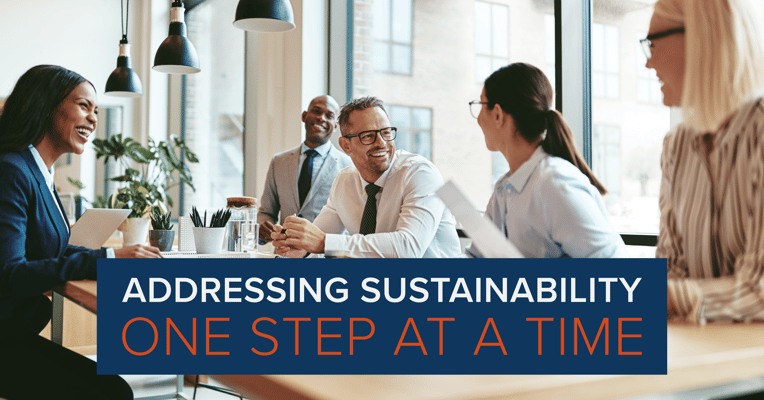Blog
Addressing Sustainability – One step at a time.

Addressing Sustainability – One step at a time
What does it mean to be a “sustainable business”?
A sustainable business is one that is not tied to the career of any one owner. A sustainable business is built on systems the perpetuate near-effortless growth. A sustainable business has a foundation that won’t be shaken by unexpected bumps in the road. A sustainable business is capable of evolving and adapting year after year.
How do you take your already successful business to “sustainable” status? Sustainability is defined by a few key elements; each can be elevated by understanding the full picture while focusing efforts on one piece at a time.
Ensure there are always guardians of the business
A multi-generational ownership team and established ownership transfer processes ensure that operations won’t be disrupted with any change in leadership. It also guarantees that your clients will never be without their trusted advisory team. You can build a capable and strong ownership by tapping valued members or your current team to participate, or by making strategic additions for future leadership.
In addition to assembling this talented team, you should be able to retain them long-term in order to contribute to the sustainability of your business. This can be achieved through competitive compensation and benefits as well as clear opportunities for professional growth.
An important piece of this particular puzzle is equity ownership. Strong owners have made the commitment to guard the success of the business and its clients for the duration of their careers. Choosing the right successors ensures that the business will always have responsible leaders at the helm. It’s important to formalize owners, not only with documented equity stake, but delineated responsibilities to the business and its clients.
As a facet of compensation, equity rewards investment and commitment through profit share. In terms of leadership, equity ownership grants a stake in decision making and the future of the business.
Build structures and mindsets that naturally perpetuate success
Sustainable businesses have established, efficient processes and foundational structures that inherently create profit, and therefore the means for continued investment in improvement. This starts with the business’s cash flow.
Centralizing cashflow within the entity–rather than individual advisors–gives the business the ability to collect all revenue and pay out expenses with predictability. This predictability allows the business to plan for and execute critical investments in efficiencies perpetuate long-term sustainability, including people, processes, and technology.
/cashflowgraph_profitdist_larger-01.png?width=5000&name=cashflowgraph_profitdist_larger-01.png)
Like compensation structure and equity, improving cash flow comes from an assessment of how things flow currently, and identifying which pieces can be tweaked for maximum impact. Some common considerations are: Which technologies are you currently using? Are they the most cost-effective and robust option for your business? Are support expenses pooled under the entity, or does each advisor manage their own office resources?
The other element of self-perpetuating growth and sustainability is the culture and mindset of your team. The professionals on your team must consider themselves just that: a team working together to drive performance, sharing in both the responsibility and the rewards of growth. When cashflow and compensation are effectively structured, this mentality is supported with measurable results and incentives. Additionally, standard business practices, communication, and overall culture can set the example to cultivate a “common goal” mentality.
This mindset can be further supported through compensation that rewards a professional’s commitment and contribution to the overall business growth. This can be accomplished through equity ownership, or long-term incentive plans for non-owners. Prioritization of these rewards should be a key consideration when assessing compensation structure and cash flow.
Always look ahead – prepare to adapt, plan to evolve
Ensuring long-term sustainability requires that a business be able to make strategic plans and quickly adapt to unexpected hurdles or windfalls. Like any successful forward motion–walking, driving, skiing, sailing, etc.–this requires looking ahead to plan your speed and trajectory while navigating where you’re going to put your feet (or wheels or whatever) next.
To be both strategic and tactical in your sustainability building efforts you must have a clear picture of where you are and a good idea of where you want to go in terms of value, impact, size, or a number of other business defining factors. Only then can you plot the course from one place to the other. What steps are you going to take and why? How does each step serve your long-term goals? What shorter-term goals will help you achieve your ultimate objective?
Formulating your path can be accomplished through a formal and professional determination of business value and performance that correlates appropriate action to outcome. This assessment allows you to develop a business plan and clearly define each step of your journey, along with contingencies for bumps and unexpected detours. Building sustainability is an ongoing process. Business progress must be monitored, and plans adjusted as needed to maintain momentum.
How do you know?
Knowing where to start and building a plan for your business requires a complete and holistic view of what the business looks like today. Observation and assessment should drive action. Creating an actionable plan, poised for the highest potential of success, requires an objective and experienced point of view. Executing those actions by partnering with experts in the task at hand means you can confidently focus on your day-to-day and know that that progress towards sustainability is underway. Please let us know how we can assist you on your sustainable journey.
/Sustainability%20Blog%20Image%203-01.png?width=512&name=Sustainability%20Blog%20Image%203-01.png)